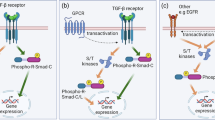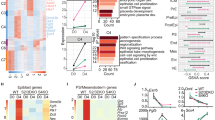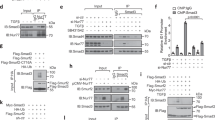Abstract
Id1 is a member of the inhibitor of differentiation (Id) protein family that regulates a wide range of cell functions. Previous studies have shown that expression of the Id1 gene is down-regulated by TGF-β in epithelial cells, whereas it is up-regulated by BMP in a variety of cell types. During our study of the biological function of TGF-β1, we found that Id1 can be strongly up-regulated by TGF-β1 in the human mammary gland epithelial cell line MCF10A. Quantitative real-time RT-PCR has revealed as high as 7.5-fold induction of Id1 mRNA by TGF-β1 in MCF10A cells after 1 h of TGF-β1 stimulation, and this induction does not require de novo protein synthesis. Using Smad knockdown and knockout approaches, we have identified Smad3 as the responsible R-Smad for mediating transcriptional activation of the Id1 gene. Chromatin immunoprecipitation assay confirms that Smad3 and Smad4 bind to the upstream region of the Id1 gene. Our results demonstrate that Smad3, but not Smad2, mediates TGF-β1-dependent early transcriptional induction of Id1.
Similar content being viewed by others
Log in or create a free account to read this content
Gain free access to this article, as well as selected content from this journal and more on nature.com
or
References
ten Dijke P, Heldin CH, eds. Smad Signal Transduction. Dordrecht: Springer, 2006.
Derynck R, Miyazono K . The TGF-β Family. Cold Spring Harbor, NY: Cold Spring Harbor Laboratory Press, 2008.
Feng X-H, Derynck R . Specificity and versatility in TGF-β signaling through Smads. Annu Rev Cell Dev Biol 2005; 21:659–693.
Feng X-H, Lin X, Derynck R . Smad2, Smad3 and Smad4 cooperate with Sp1 to induce p15Ink4B transcription in response to TGF-β. EMBO J 2000; 19:5178–5193.
Kang Y, Chen CR, Massagué J . A self-enabling TGFβ response coupled to stress signaling: Smad engages stress response factor ATF3 for Id1 repression in epithelial cells. Mol Cell 2003; 11:915–926.
Perk J, Iavarone A, Benezra R . Id family of helix-loop-helix proteins in cancer. Nat Rev Cancer 2005; 5:603–614.
Andres-Barquin PJ, Hernandez MC, Israel MA . Id genes in nervous system development. Histol Histopathol 2000; 15:603–618.
Benezra R, Rafii S, Lyden D . The Id proteins and angiogenesis. Oncogene 2001; 20:8334–8341.
Yokota Y, Mori S . Role of Id family proteins in growth control. J Cell Physiol 2002; 190:21–28.
Ruzinova MB, Benezra R . Id proteins in development, cell cycle and cancer. Trends Cell Biol 2003; 13:410–418.
de Candia P, Benera R, Solit DB . A role for Id proteins in mammary gland physiology and tumorigenesis. Adv Cancer Res 2004; 92:81–94.
Sugai M, Gonda H, Nambu Y, Yokota Y, Shimizu A . Role of Id proteins in B lymphocyte activation: new insights from knockout mouse studies. J Mol Med 2004; 82:592–599.
Wong YC, Wang X, Ling MT . Id-1 expression and cell survival. Apoptosis 2004; 9:279–289.
Sun XH, Copeland NG, Jenkins NA, Baltimore D . Id proteins Id1 and Id2 selectively inhibit DNA binding by one class of helix-loop-helix proteins. Mol Cell Biol 1991; 11:5603–5611.
Langlands K, Yin X, Anand G, Prochownik EV . Differential interactions of Id proteins with basic-helix-loop-helix transcription factors. J Biol Chem 1997; 272:19785–19793.
Vinals F, Ventura F . Myogenin protein stability is decreased by BMP-2 through a mechanism implicating Id1. J Biol Chem 2004; 279:45766–45772.
Einarson MB, Chao MV . Regulation of Id1 and its association with basic helix-loop-helix proteins during nerve growth factor-induced differentiation of PC12 cells. Mol Cell Biol 1995; 15:4175–4183.
Parrinello S, Lin CQ, Murata K, et al. Id-1, ITF-2, and Id-2 comprise a network of helix-loop-helix proteins that regulate mammary epithelial cell proliferation, differentiation, and apoptosis. J Biol Chem 2001; 276:39213–39219.
Zheng W, Wang H, Xue L, Zhang Z, Tong T . Regulation of cellular senescence and p16INK4A expression by Id1 and E47 proteins in human diploid fibroblast. J Biol Chem 2004; 279:31524–31532.
Ohtani N, Zebedee Z, Huot TJ, et al. Opposing effects of Ets and Id proteins on p16INK4A expression during cellular senescence. Nature 2001; 409:1067–1070.
Inoue T, Shoji W, Obinata M . MIDA1, an Id-associating protein, has two distinct DNA binding activities that are converted by the association with Id1: a novel function of Id protein. Biochem Biophys Res Commun 1999; 266:147–151.
Nieborowska-Skorska M, Hoser G, Rink L, et al. Id1 transcription inhibitor-matrix metalloproteinase 9 axis enhances invasiveness of the breakpoint cluster region/Abelson tyrosine kinase-transformed leukemia cells. Cancer Res 2006; 66:4108–4116.
Singh J, Itahana Y, Parrinello S, Murata K, Desprez PY . Molecular cloning and characterization of a zinc finger protein involved in Id-1-stimulated mammary epithelial cell growth. J Biol Chem 2001; 276:11852–11858.
Volpert OV, Pili R, Sikder HA, et al. Id1 regulates angiogenesis through transcriptional repression of thrombospondin-1. Cancer Cell 2002; 2:473–483.
Hasskarl J, Duensing S, Manuel E, Munger, K . The helix-loop-helix protein ID1 localizes to centrosomes and rapidly induces abnormal centrosome numbers. Oncogene 2004; 23:1930–1938.
Miyazono K, Miyazawa K . Id: a target of BMP signaling. Sci STKE 2002; 151:PE40.
Chambers RC, Leoni P, Kaminski N, Laurent GJ, Heller RA . Global expression profiling of fibroblast responses to transforming growth factor-beta1 reveals the induction of inhibitor of differentiation-1 and provides evidence of smooth muscle cell phenotypic switching. Am J Pathol 2003; 162:533–546.
Wiercinska E, Wickert L, Denecke B, et al. Id1 is a critical mediator in TGF-β-induced transdifferentiation of rat hepatic stellate cells. Hepatology 2006; 43:1032–1041.
Lopez-Rovira T, Chalaux E, Massagué J, Rosa JL, Ventura F . Direct binding of Smad1 and Smad4 to two distinct motifs mediates bone morphogenetic protein-specific transcriptional activation of Id1 gene. J Biol Chem 2002; 277:3176–3185.
Korchynskyi O, ten Dijke P . Identification and functional characterization of distinct critically important bone morphogenetic protein-specific response elements in the Id1 promoter. J Biol Chem 2002; 277:4883–4891.
Agalioti T, Chen G, Thanos D . Deciphering the transcriptional histone acetylation code for a human gene. Cell 2002; 111:381–392.
Kurdistani SK, Tavazoie S, Grunstein M . Mapping global histone acetylation patterns to gene expression. Cell 2004; 117:721–733.
Feng X-H, Zhang Y, Wu R-Y, Derynck R . The tumor suppressor Smad4/DPC4 and transcriptional adaptor CBP/p300 are coactivators for Smad3 in TGF-β-induced transcriptional activation. Genes Dev 1998; 12:2153–2163.
Janknecht R, Wells NJ, Hunter T . TGF-beta-stimulated cooperation of Smad proteins with the coactivators CBP/p300. Genes Dev 1998; 12:2114–2119.
Shen X, Hu PP, Liberati NT, Datto MB, Frederick JP, Wang XF TGF-beta-induced phosphorylation of Smad3 regulates its interaction with coactivator p300/CREB-binding protein. Mol Biol Cell 1998; 9:3309–3319.
Kang JS, Alliston T, Delston R, Derynck R . Repression of Runx2 function by TGF-β through recruitment of class II histone deacetylases by Smad3. EMBO J 2005; 24:2543–2555.
Derynck R, Piek E, Schneider RA, Choy L, Alliston T . TGF-β family signaling in mesenchymal differentiation. In: Derynck R, Miyazono K, eds. The TGF-β Family. Cold Spring Harbor: Cold Spring Harbor Laboratory Press, 2008:613–666.
Swarbrick A, Akerfeldt MC, Lee CS, et al. Regulation of cyclin expression and cell cycle progression in breast epithelial cells by the helix-loop-helix protein Id1. Oncogene 2005; 24:381–389.
Di K, Ling MT, Tsao SW, Wong YC, Wang X . Id-1 modulates senescence and TGF-β1 sensitivity in prostate epithelial cells. Biol Cell 2006; 98:523–533.
Ling MT, Wang X, Tsao SW, Wong YC . Down-regulation of Id-1 expression is associated with TGF-β1-induced growth arrest in prostate epithelial cells. Biochim Biophys Acta 2002; 1570:145–152.
Alani RM, Young AZ, Shifflett CB . Id1 regulation of cellular senescence through transcriptional repression of p16/Ink4a. Proc Natl Acad Sci USA 2001; 98:7812–7816.
Nickoloff BJ, Chaturvedi V, Bacon P, Qin JZ, Denning MF, Diaz Mo . Id-1 delays senescence but does not immortalize keratinocytes. J Biol Chem 2000; 275:27501–27504.
Tang J, Gordon GM, Nickoloff BJ, Foreman KE . The helix-loop-helix protein Id-1 delays onset of replicative senescence in human endothelial cells. Lab Invest 2002; 82:1073–1079.
Lin X, Duan X, Liang YY, et al. PPM1A functions as a Smad phosphatase to terminate TGF-β signaling. Cell 2006; 125:915–928.
Tournay O, Benezra R . Transcription of the dominant-negative helix-loop-helix protein Id1 is regulated by a protein complex containing the immediate-early response gene Egr-1. Mol Cell Biol 1996; 16:2418–2430.
Shang Y, Hu X, DiRenzo J, Lazar MA, Brown M . Cofactor dynamics and sufficiency in estrogen receptor-regulated transcription. Cell 2000; 103:843–852.
Acknowledgements
We thank Robert Benezra (Sloan-Kettering Institute, NY, USA) for Id1-luc reporter constructs and Ed Leof (Mayo Clinic, MN, USA) for anti-phospho-Smad3 antibody. We are grateful to Xin-Hua Feng (Baylor College of Medicine, TX, USA)for critically reading the manuscript and stimulating discussions. This research was supported by NIH grant R01DK073932, USA and partly by the Baylor Breast Center SPORE career development award, USA.
Author information
Authors and Affiliations
Corresponding author
Rights and permissions
About this article
Cite this article
Liang, YY., Brunicardi, F. & Lin, X. Smad3 mediates immediate early induction of Id1 by TGF-β. Cell Res 19, 140–148 (2009). https://doi.org/10.1038/cr.2008.321
Received:
Revised:
Accepted:
Published:
Issue date:
DOI: https://doi.org/10.1038/cr.2008.321
Keywords
This article is cited by
-
Deep learning for de-convolution of Smad2 versus Smad3 binding sites
BMC Genomics (2022)
-
Id proteins: emerging roles in CNS disease and targets for modifying neural stemcell behavior
Cell and Tissue Research (2022)
-
Cancer microenvironment and genomics: evolution in process
Clinical & Experimental Metastasis (2022)
-
Interplay between transforming growth factor-β and Nur77 in dual regulations of inhibitor of differentiation 1 for colonic tumorigenesis
Nature Communications (2021)
-
CRISPR screens identify cholesterol biosynthesis as a therapeutic target on stemness and drug resistance of colon cancer
Oncogene (2021)



